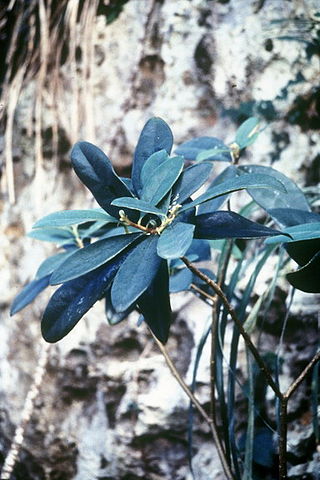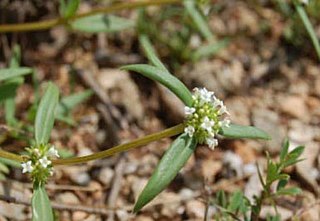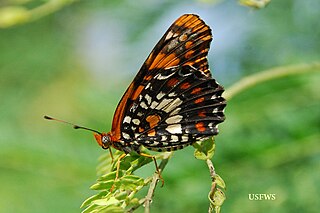
The elfin woods warbler is a species of bird endemic to Puerto Rico, where it is local and uncommon. Discovered in 1968 and described in 1972, it is the most recently described New World warbler.
Myrcia neothomasiana, commonly known as Thomas' lidflower, is a rare species of plant in the family Myrtaceae. It is found on three Caribbean islands. There are fewer than 250 individuals total divided amongst the islands of Vieques in Puerto Rico, St. John in the United States Virgin Islands, and Virgin Gorda in the British Virgin Islands. It has been extirpated from the wild on Saint Thomas, U.S. Virgin Islands, where it was first described in 1855, and now only grows there in cultivation.

Eugenia haematocarpa is a rare species of plant in the family Myrtaceae. It is endemic to Puerto Rico. It is classified as an endangered species by the U.S. Fish and Wildlife Service and there has been a plan for its recovery in place for some years. Its common names include uvillo and Luquillo Mountain stopper.

Eugenia woodburyana is a species of plant in the family Myrtaceae. It is endemic to Puerto Rico. It is a federally listed endangered species of the United States. It is threatened by habitat loss.
Pleodendron macranthum (chupacallos) is a rare species of tree in the family Canellaceae. It is endemic to Puerto Rico, where there are only three tiny populations remaining. Two individual plants are located in El Yunque and 8 to 10 plants remain in Río Abajo State Forest. This tree is a federally listed endangered species of the United States.

Ceanothus ferrisiae is a rare species of shrub in the family Rhamnaceae. Its common name is coyote ceanothus.
Aristida portoricensis is a rare species of grass known by the common name pelos del diablo. It is endemic to Puerto Rico, where it is known from two locations, one in a residential area of Mayagüez and one in the Sierra Bermeja. Two other known sites have been extirpated by development of the habitat. It is a federally listed endangered species of the United States.

Catesbaea melanocarpa is a rare species of flowering plant in the coffee family known by the common name tropical lilythorn. It is native to five Caribbean islands: Puerto Rico, St. Croix in the United States Virgin Islands, Antigua, Barbuda, and one island in Guadeloupe. The plant is threatened by habitat loss.

Cornutia obovata is a rare species of tree in the mint family, and formerly considered a member of the verbena family. It is endemic to forested slopes in Puerto Rico, where its common names are capá jigüerilla, nigua, and palo de nigua. When it was added to the endangered species list of the United States in 1988 there were only seven individuals known to remain in the wild. By 1998 there were eight plants known. This is considered one population divided amongst a few locations in the mountain forests of the island.

Daphnopsis hellerana is a rare species of flowering plant in the genus Daphnopsis of the family Thymelaeaceae. It is endemic to Puerto Rico, where there were only four populations remaining in 1992, with a total of 125 individuals. It was federally listed as an endangered species of the United States in 1988.
Elaphoglossum serpens is a rare species of fern that grows only on Cerro de Punta, the highest mountain in Puerto Rico. The fern grows at one location, where there are 22 known specimens. It was federally listed as an endangered species of the United States in 1993.

Gesneria pauciflora is a rare species of flowering plant in the family Gesneriaceae known by the common name yerba maricao de cueva. It is endemic to Puerto Rico, where there are only three populations remaining. It was federally listed as a threatened species of the United States in 1995.
Lepanthes eltoroensis is a species of orchid known by the common name Luquillo Mountain babyboot orchid. It is endemic to El Yunque National Forest in Puerto Rico, growing primarily in the Luquillo Mountains. It is named for the El Toro Trail in the mountains. It was a federally listed endangered species of the United States from 1991 to 2021, when it was delisted due to recovery.

Mitracarpus maxwelliae is a rare species of flowering plant in the coffee family known by the common name Maxwell's girdlepod. It is endemic to Puerto Rico, where it is known only from the Guánica Commonwealth Forest in Guánica. It grows in only one location in a coastal scrub forest and dwarf forest with limestone gravel substrates. Other plants in the habitat include Bucida buceras, Bursera simaruba, Exostema caribaeum, Coccoloba microstachya, Plumeria alba, and Pilosocereus royenii.

Mitracarpus polycladus is a rare species of flowering plant in the coffee family known by the common name cana gorda girdlepod. It is native to Puerto Rico, where it is known only to come from the Guánica Commonwealth Forest. It can also be found on the island of Saba. It grows in coastal scrub forest and dwarf forest with limestone gravel substrates. Other plants in the habitat include Bucida buceras, Bursera simaruba, Exostema caribaeum, Coccoloba microstachya, Plumeria alba, and Pilosocereus royenii.
Ottoschulzia rhodoxylon is a rare species of tree in the family Icacinaceae known by the common name pincho palo de rosa. It is native to Puerto Rico and Hispaniola. When it was listed as an endangered species under the United States' Endangered Species Act in 1990 there were only nine individuals remaining on Puerto Rico.
Amauropelta inabonensis, synonym Thelypteris inabonensis, is a rare species of fern known by the common name cordillera maiden fern. It is endemic to Puerto Rico, where it is known from only two localities: at the headwaters of Río Inabón and at the Toro Negro State Forest. It is a federally listed endangered species of the United States.

Thlaspi californicum is a rare species of flowering plant in the family Brassicaceae known by the common name Kneeland Prairie penny-cress. It is endemic to California, where it is known from only one stretch of grassland in Humboldt County. It is threatened by development. It is a federally listed endangered species of the United States.

Atlantea tulita is a rare species of butterfly known by the common name Puerto Rico harlequin butterfly. This brush-footed butterfly is endemic to Puerto Rico. It is a candidate for United States federal protection as an endangered species. In 2011 a report found federal protection to be warranted, but it was precluded by other actions and it remains a candidate.

Varronia bellonis, commonly known as the serpentine manjack, is a species of flowering plant that was first reported in Susúa Puerto Rico in 1992, where a small group of five individuals was found. This endangered shrub is endemic to Puerto Rico. Due to habitat destruction, as of 1997, only 99 known plants remained in the wild, and the population of V. bellonis appeared to be in rapid decline. This discovery has spurred a reintroduction effort in Puerto Rico.













